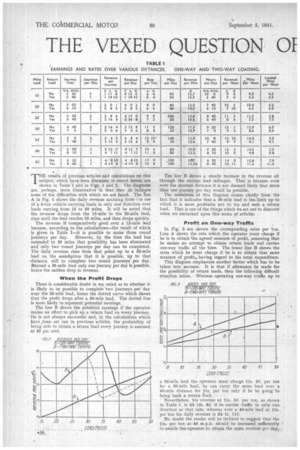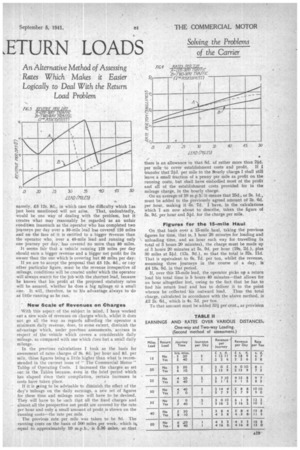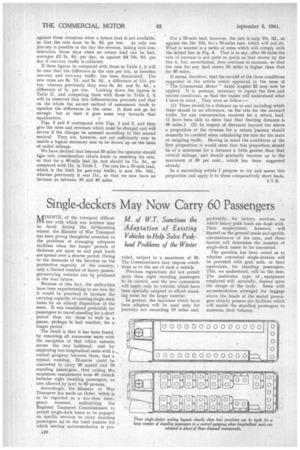THE VEXED QUESTION Of LETURN LOADS
Page 20

Page 21

Page 22

If you've noticed an error in this article please click here to report it so we can fix it.
An Alternative Method of Assessing Rates Which Makes it Easier Logically to Deal With the Return Load Problem THE results of previous articles and calculations on this subject, which have been discussed in recent issues, are shown in Table I and in Figs. 1 and 2. The diagrams are, perhaps, more illuminative in that they do indicate some of the difficulties with which we are faced. The fine
A in Fig. 1 shows the daily revenue accruing from use of a 5-ton vehicle carrying loads in only one direction over leads varying from 15 to 50 miles. It will be noted that the revenue drops from the 15-mile to the 20-mile lead, rises until the lead reaches 35 miles, and then drops quickly.
The revenue g comparatively good over a 15-mile lead because, according to. the calculations-the result of which is given in Table I-it is possible to make three round journeys per day. However, by the time the lead has extended to 20 miles that possibility has been eliminated and only two round journeys per day can be completed. The daily revenue rises from that point up to a 35-mile lead on the assuiliption that it is possible, up to that distance, still to complete two round journeys per day. Beyond a 35-mile lead only one journey per day is possible, hence the sudden drop in revenue.
When the Profit Drops There -is considerable doubt in my mind as to whether it is likely to be possible to complete 'two journeys per 'day over the 35-mile lead, hence the dotted curve which shows that the profit drops after a 30-mile lead. The dotted line is more likely to represent potential earnings.
The line B shows the potential earnings if the operator. makes an effort to pick up a return load on every journey. He is not always successful and, in the calculations which have ,been set out in previous articles, the probability of being able to obtain a return load every journey is assessed at 60 per cent. The line B shows a steady increase in the revenue all through the various lead mileages. That is because even over the shortest distance it is not deemed likely that more than one journey per day would be possible.
The usefulness of this diagram comes chiefly from the fact that it indicates that a 30-mile lead is the limit up to which it is more profitable not to try and seek a return load. That is one of the things which we set out to discover when we embarked upon this series of articles.
Profit on One-way Traffic
In Fig. 2 are shown the corresponding rates per ton. Line A shows the rate which the operator must charge if he is to obtain the agreed measure of profit, assuming that he makes no attempt to obtain return loads and carries one-way traffic all the time. The lower line B shows the rates which he must charge if he is to obtain that same measure of profit,. having regard to his total expenditure.
This diagram emphasizes another factor which has to be taken into account. It is that if allowance be made for the possibility of return loads, then the following difficult situation arises. Whereas operating one-way traffic up to a 30-mile lead the operator must charge 11s. 3d. per ton for a 30-mile haul, he can carry the same load over a 40-mile distance for Ils. per ton only if he be going to bring' back a return 'toad.
Nevertheless, his revenue at 11s. 3d. per ton, as shown in Table 1, is 25 12s. 8d. if he carries traffic in only one direction at that rate, whereas over a 40-mile lead at lls, per ton his daily revenue is 24 is. lid.
No doubt the reader will be inclined to suggest that the lls, per ton at 40 m.p.h. should be increased sufficiently • to enable the operator to obtain the same revenue pc: day,„ namely, £5 12s. 8d., in which case the difficulty which Eas just been mentioned will not arise. That, undoubtedly, would be one way of dealing with the problem, but it creates what may reasonably be regarded as an unfair condition inasmuch as the operator who has completed two joarneys per day over a 30-mile lead has covered 120 miles and on the face of it is entitled to a bigger revenue than the operator who, over a 40-mile lead and running only one journey per day, has covered no more than 80 miles.
It seems fair that a vehicle running 120 miles per day should earn a bigger revenue and a bigger net profit for its owner than the one which is covering but 80 miles per day: If we are to accept the proposal that £5 12s. 8d., or zny other particular figure, must be the revenue irrespective of mileage, conditions will be created under which the operator will always search for the job with the shortest lead, because he knows that his profit at the proposed statutory rates will be assured, whether he does a big mileage or a small one. It will, therefore, be to his advantage always to do as little running as he can.
New Scale of Revenues on Charges
With this aspect of the subject in mind. I have worked out a new scale of revenues on charges which, whilst it does not go all the way as regards affording the operator minimum daily revenue, does, to some extent, diminish the advantage which, under previous assessments, accrues in respect of the vehicle which covers a considerable daily mileage, as compared with one which cloes but a sm-all daily mileage.
In the previous calculations I took as the basis for assessment of rates charges of 9s. 6d. per hour and 8d. per mile, those figures being a little higher than what is recomMended in the current issue of " The Commercial Motor's Tableis of Operating Costs. I increased the charges as set out in the Tables because, even in the brief period which has elapsed since their compilation, certain increases in costs have taken place.
If it is ping to be advisable to dieninish the effect of the day's -mileage on the daily earnings, a new set of figures for these time and mileage rates will have to be devised. They will have to be such that all the fixed charges-and almost all the prospective net profit are covered by the rate per hour and only a small amount of profit is shown on the running costs-the rate per. mile.
The previous rate per mile was taken to be &I. The running costs on the basis of 500 miles per week, which is, equal to approximately 10 m.p.h., is 5.36 miles, so that
there is an allowance in that 8d. of rather more than 24d.
per mile -to cover establishment costs and profit. If I transfer that-21d. per mile to the itourly charge I shall still leave a small fraction of a penny per mile as profit on the running costs, but shall have embodied most of the profit and all of the establishment costs provided for in the mileage charge, in the hourly charge.
On an average of 10 m.p.h.' it-means that 25d., or 2s. ld., must be added to the previously agreed amount of 35. 6d. per hour, making it 5s. 7d. I have, in the calculations which I am now about to describe, taken the figure of 5s. 9d. per hour and 54d. for the charge per mile.
Figures for the 15-mile Haul
-On that basis over a 15-mile haul, taking the previous figures for time, that is, 1 hour 20 minutes for loading and unloading time, and an hour each way for travelling (a total of 3 hours 20 minutes), the charge must be made up of 3 hours 20 minutes at 5s. 9d. per hour (19s. 2d.), plus 30 miles at 51d. (13s. 9d.), so that the total is 32s. lid. That is equivalent to 6s. 7d. per ton, whilst the revenue, assuming three journeys in the course of a day, is 44 18s. 9d. in that period.
If, over this 15-mile lead, the operator picks up a return load his total time is 5 hours 40 minutes-that allows for an hour altogether lost, owing to the fact that he has to find his return load and has to deliver it to the point whence he collected his outward load. Thus the total charge, calculated in accordance with the above method, is £2 2s. 6c1., which is 4s. 3d. per ton.
To that amount must be added 33i per cent., as provision
against those occasions when a return load is not available: so that the rate must be 5s. 8d. per ton. As only one journey is possible in the day the revenue, taking into consideration those days when no return load can be had, averages £2 2s. 6d-. per day, as against £4 18s. 9d. per day if one-way traffic is collected.
If these figures be compared with those in Table I, it will be seen that the difference in the rate per ton, as between one-way and two-way traffic, has been diminished. The new rates are fis 7d. and 5s. 8d., a difference of 11d, per ton, whereas previously they were 6s. 4d, and 5s. 4d., a difference of Is. per ton. Looking down the figures in Table II, and comparing them with those in Table I, it will be observed that this differentiation proceeds and that on the whole the second method of assessment tends to equalize the differences in the rates. It does not go far enough, but at least it goes some way towards that equalization.
Figs. 3 and 4 correspond with Figs. 1 and 2, and they give the rates and revenue's which must be charged and will accrue if the charges be assessed according to this second method. They are, however, not yet sufficiently near to enable a logical statutory rate to be drawn up on the basis of radial mileage.
We have decided that beyond 30 miles the operator should tq,ke into consideration return /loads in assessing his rate, so that for a 40-mile lead his rate should be 1 Is. 3d., as compared with us, in Table I. The rate for a 30-mile lead, which is the limit for sine-way traffic, is now 10s. 10d., whereas previously it was us., so that we now have an increase as between 30 and 40 miles.
For a 35-mile lead, however, the rate is only 10s. 3d., as against the 10s. 10d. for a 30-miles lead, which will not do. What is wanted is a series of rates which will comply with the dotted line in Fig. 4. That is to say, after 30 miles the rate of increase is not quite so quick as that shown by the line A, but, nevertheless, does continue to increase, so that the rate for any lead above 30 miles is higher than that for 40 miles,
It seems-, therefore, that the second of the three conditions suggested in .the article which appeared in the issue of 'The Commercial Motor" dated August 22 may now be applied. It is, perhaps, necessary to repeat the first and second conditions, so that the reader will understand what I have in mind.. They were as follow :—
(1) There should he a distance up to and including which there should be no allowance, on the rate for the outward traffic, for any remuneration received for a return load. (I have been able to show that that limiting distance is 30 miles.) (2) In respect of distances beyond the above a proportion of the revenue for a return journey should normally be credited when calculating the rate for the main or outgoing traffic. Having in mind the conditions of the first proposition it would seem that this proportion should be at -a minimum for a distance a little greater than that critical mileage, and should gradually increase up to the maximum of 60 per cent., which has been suggested already.
In a succeeding article I propose to try and assess this proportion and apply it to these comparatively short leads.
• S.T.R.




















































